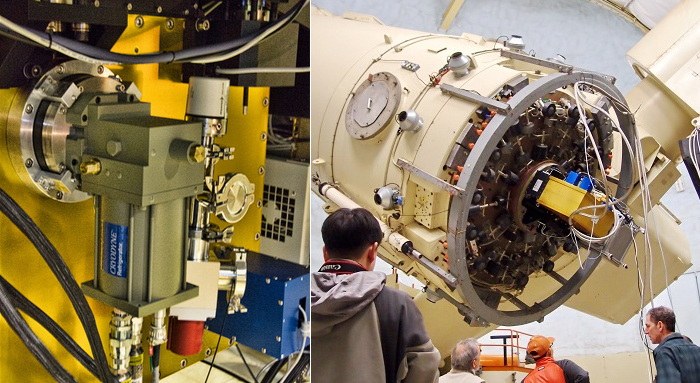Immersion GRating INfrared Spectrometer

IGRINS, the Immersion Grating INfrared Spectrometer, is a cross-dispersed near-IR spectrograph with a resolving power R=λ/Δλ = 45,000 (Yuk et al. 2010, Park et al. 2014). It can observe all of the H and K windows, ~1.5 to 2.5 microns, in a single exposure. This coverage represents a revolutionary increase in spectral grasp (instantaneous spectral coverage) at high resolution enabled by the use of a silicon immersion echelle grating and two 2Kx2K infrared detectors. IGRINS has an infrared slit-viewing camera for rapid acquisition in the K band. It has a single observing mode and no cryogenic moving parts. This simple design makes it easy for new observers to master and allows the instrument team to provide a simple data reduction pipeline. The pipeline is primarily authored by Dr. Jae-Joon Lee (KASI) and is publicly available. By making use of the latest low-noise detectors and of a Si immersion grating and VPH cross-dispersers, IGRINS has the sensitivity to attack a broad range of astronomical problems (see Astronomy with IGRINS ). The instrument sits at the Cassegrain focus of the 2.7 meter and the slit size is 1”x14”, with 3.5 pixel sampling across the slit. Further technical details are available in Yuk et al. (2010, Proc. SPIE 7735) and Park et al. (2014, Proc. SPIE 9147).
Instrument paper
A PASP paper is being written, but initial capabilities are discussed by Park et al. (2014). http://adsabs.harvard.edu/abs/
User manual (to be written)
The IGRINS user manual is under development and hosted as a UT wiki: https://wikis.utexas.edu/display/
This page has much of the information needed by proposers, observers, and the instrument team. Past newsletters are also hosted on the wiki: https://wikis.utexas.edu/display/
Detectors:
IGRINS employs three Teledyne H2RG HgCdTe detectors. The H- and K-band spectrograph channels use science-grade 2.5 μm cutoff sensors, while the slit-viewing camera makes use of an engineering-grade sensor. Each detector set is controlled by a SIDECAR ASIC cryogenic board and a JADE2 USB interface card. Filters: IGRINS is a white pupil spectrograph without cryogenic mechanisms. The silicon immersion grating absorbs light short of ~1.2 microns and the detector cutoffs are at 2.5 microns. No filters are employed for the spectral detectors.
Guiding:
Guiding with IGRINS is achieved with an ~2x3 arcminute slit-viewing camera behind a Ks filter. Guiding is automated using custom routines and user interfaces.
Observing:
IGRINS is available to anybody who applies for McDonald observing time. As a PI instrument that is a prototype of the GMTNIRS instrument under development at UT, IGRINS observing generally requires two people. The instrument and telescope are controlled on two different computers. The telescope can not be taken over the axis with IGRINS. New IGRINS observers need to contact the team postdocs, Drs. Gregory Mace or Hwihyun Kim, for proper scheduling and proposing procedures.
Calibrations:
A calibration unit sits in front of the cryostat window and provides pseudo-darks, flats, ThAr and UNe lamps. These are taken in 40 minutes at the start and end of the night. Calibrations do not need to be supervised and are stable over many weeks to months.
Data reduction software:
The IGRINS data reduction software is primarily authored by Dr. Jae-Joon Lee (KASI), is written in python, and is publicly available on github (https://github.com/igrins/plp). Since the format and instrument setup of IGRINS is fixed, the pipeline is mostly automated. The pipeline subtracts AB pairs to remove OH emission lines and then optimally extracts the sources based on the methods of Horne (1986). The wavelength solution is determined first from ThAr lamp spectra taken at the start of each night, and then improved by fitting the OH lines in the two dimensional target spectra. The flux, wavelength, signal-to-noise and variance of every extracted order is output as a FITS file for the H and K bands separately. The PLP should be cited using this DOI: https://zenodo.org/record/18579#.VX7zPeuTrlc
Acknowledgments:
Publication of IGRINS observations should use this standard acknowledgement:
This work used the Immersion Grating Infrared Spectrograph (IGRINS) that was developed under a collaboration between the University of Texas at Austin and the Korea Astronomy and Space Science Institute (KASI) with the financial support of the US National Science Foundation under grant AST-1229522, of the University of Texas at Austin, and of the Korean GMT Project of KASI.
Publication Policy:
All IGRINS users need to review the publication policy prior to proposing for telescope time and submitting papers for publication. https://wikis.utexas.edu/display/







